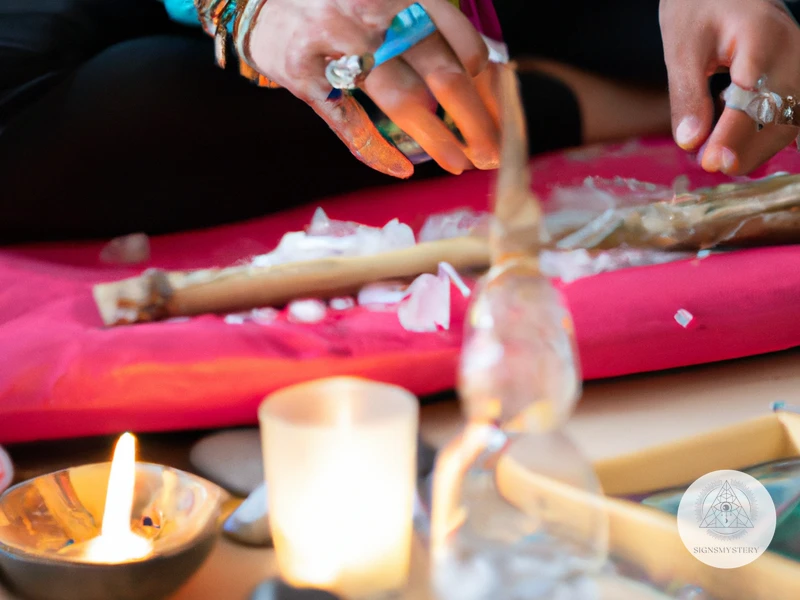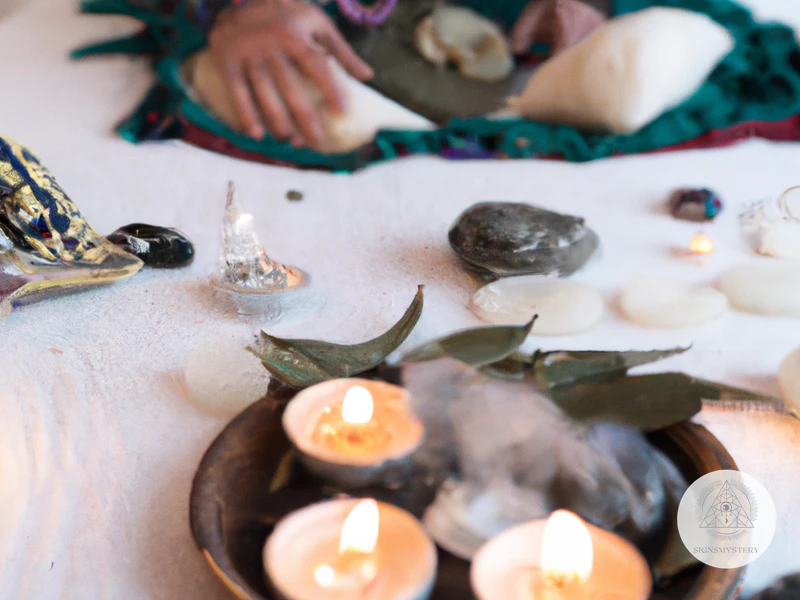Are you looking for a holistic approach to healing your mind, body, and soul? Shamanic healing may be just what you need to tap into the power of nature and the spiritual world to find balance and wellness. But before you dive into a shamanic healing session, you’ll need to prepare yourself both mentally and physically. In this comprehensive guide, we’ll take you through the step-by-step process of preparing for a shamanic healing session, what to expect during the session, and what to do after the healing. So, take a deep breath, let go of any expectations, and journey with us into the world of shamanic healing.
What is Shamanic Healing?

Shamanic healing is an ancient practice that has been used by indigenous cultures all over the world for centuries. This healing modality involves accessing non-ordinary states of consciousness and working with spiritual energies and entities for the purpose of bringing balance, harmony, and healing to the individual.
The shamanic approach to healing recognizes that everything is interconnected and that true healing requires addressing the root cause of the problem rather than just alleviating symptoms. It understands that illnesses and imbalances can be caused by factors such as emotional distress, spiritual disconnection, trauma, and negative energy from past experiences.
Shamanic healing involves the use of various techniques such as drumming, chanting, rattling, and journeying to help an individual enter an altered state of consciousness and access deeper levels of awareness. During a session, the shaman or practitioner may work with spirit guides, power animals, and other spiritual entities to gain insight and guidance for the healing process.
Unlike modern medicine that focuses mainly on physical symptoms, shamanic healing addresses the whole person – physical, emotional, and spiritual aspects. It emphasizes that true healing requires aligning all aspects of the individual with their purpose and with the natural world around them.
Interested in learning more about the benefits of shamanic healing? Check out our comprehensive guide today!
Benefits of Shamanic Healing
Shamanic healing is an ancient practice that has stood the test of time due to its numerous benefits. Physical benefits include relief from chronic pain, digestive issues, insomnia, and migraines. Emotional benefits include releasing emotional baggage, reducing anxiety and depression, and improving self-esteem and confidence. Spiritual benefits are also experienced which include increased connection to nature, spiritual awakening, and a sense of purpose. Studies have shown that shamanic healing can also complement modern medicine by enhancing the healing process. Shamanic healing techniques can help individuals suffering from trauma and emotional distress. Shamanic healing provides a holistic approach to healing the mind, body, and spirit, and plays a vital role in modern society.
Physical Benefits
Shamanic healing has numerous physical benefits that can help you in living a healthy and peaceful life. Here are some of the physical benefits of shamanic healing:
| Benefits | Description |
|---|---|
| Pain Relief | Shamanic healing helps to reduce physical pain and inflammation, which can be beneficial for those suffering from chronic pain. |
| Improved Sleep | Shamanic healing can help you get better sleep by reducing stress and anxiety, allowing you to sleep more soundly and feel more rested. |
| Detoxification | Shamanic healing helps to detoxify the body by removing toxins and negative energy, which can help improve your overall physical health. |
| Boosted Immunity | Shamanic healing can help to improve your immune system by reducing stress and increasing the production of immune cells and antibodies. |
| Increased Energy | Shamanic healing can help to increase your energy levels by clearing blockages and balancing energy flow in your body, allowing you to feel more revitalized and energized. |
Shamanic healing techniques have been used for centuries to treat physical ailments and promote overall well-being. While shamanic healing is not a replacement for modern medicine, it can be used in conjunction with traditional treatment methods to achieve optimal health. If you are dealing with physical issues or chronic pain, shamanic healing may be worth exploring.
Emotional Benefits
Shamanic healing has been found to have numerous emotional benefits. Some of these benefits include:
| Benefits | Description |
|---|---|
| Reduces anxiety and stress | Shamanic healing techniques often involve deep relaxation, which helps in reducing anxiety and stress. Shamanic spirituality can help an individual to perceive their problems in a more holistic way, thus reducing distress. |
| Helps to heal the emotional wound | Shamanic healing can help an individual to heal the emotional wounds that can cause pain and discomfort. Through various techniques, shaman can help in identifying the source of emotional distress and provide the necessary tools needed to heal it. |
| Promotes emotional balance | Shamanic healing can help an individual achieve emotional balance by identifying and addressing the root cause(s) of problems that can contribute to emotional distress. |
| Facilitates emotional release | Shamanic healing techniques can often lead to emotional release, helping one to let go of negativities and emotional baggage accumulated over time. |
| Encourages self-awareness and self-acceptance | Shamanic healing can help an individual to recognize the various aspects of their own personality, both positive and negative ones, thus promoting self-awareness. Through this self-awareness, an individual can learn to accept their own experiences and emotions, thereby promoting self-acceptance, which can help in overall well-being. |
Emotional benefits of shamanic healing can be a powerful tool to overcome emotional distress and promote overall well-being. Shamanic healing can complement modern medical practices as part of integrated healthcare. To learn more about how shamanic healing can help in emotional distress and trauma, check out our article on Shamanic healing for trauma and emotional distress.
Spiritual Benefits
Shamanic healing provides many spiritual benefits that can help a person achieve a deeper level of connection with their spiritual self and the world around them. Some of the spiritual benefits of shamanic healing are:
| 1. Connection with Spirit Guides: | Shamanic healing can help you connect with your spirit guides who can offer guidance and support as you navigate your spiritual path. |
| 2. Expanded Consciousness: | During a shamanic healing session, you may experience altered states of consciousness, which can lead to a greater understanding of your spiritual self and the world. |
| 3. Release of Negative Energy: | Shamanic healing techniques help to release negative energy from the body and spirit, allowing for a sense of lightness and spiritual clarity. |
| 4. Emotional Healing: | Shamanic healing can help to heal emotional wounds, allowing you to let go of past traumas and connect with your emotions in a healthy and positive way. |
| 5. Spiritual Growth: | Shamanic healing can facilitate spiritual growth, helping you to explore your spirituality and expand your understanding of the universe. |
These are just a few of the many spiritual benefits that shamanic healing can provide. By working with a trained shaman and using powerful techniques, you can explore your spirituality and connect with your true self on a deeper level.
If you want to learn more about shamanic healing and its spiritual benefits, check out our article on Shamanic Spirituality or Shamanic Healing Ethics and Limits.
Preparing for your Shamanic Healing Session

Preparing for a shamanic healing session is an important step towards receiving the full benefit of the experience. Before the session, research and find a reputable shaman who aligns with your values and beliefs. Once you have found a shaman, reach out to them and ask any questions you may have about the process or their shamanic healing techniques. It is important to follow any instructions provided by the shaman, such as avoiding over-stimulating foods and drinks, finding a calm and safe place for the session, and dressing comfortably. You can also prepare for the session by setting an intention for what you hope to achieve from the experience, and bringing any objects or items that hold personal significance to you. Prioritize self-care and relaxation before your session, and try to clear your mind of any distractions. By properly preparing for your shamanic healing session, you can open yourself up to transformative emotional, physical, and spiritual healing.
Research and Find a Shaman
Research and Find a Shaman: Before scheduling a Shamanic healing session, it is essential to research and find a reliable and experienced shaman. You may check online directories or local shamanic communities to find a list of shamans near you. It is important to vet the shaman before scheduling an appointment and ensure that their values and methods align with your expectations. You might want to read reviews or ask for referrals from friends who have experienced shamanic healing sessions themselves.
It is also important to keep in mind that not all shamans are a good fit for everyone. Each shaman has a unique style and approach to shamanic healing. Some shamans might specialize in specific types of healing practices or have more experience working with certain conditions. It is essential to find a shaman whose approach resonates with you.
It is recommended to thoroughly check the shaman’s website or profile to understand their experience, credentials, and any specializations. You can also check if they offer an initial consultation or discovery session before the actual healing session. This session would help you connect with the shaman and discuss any queries or concerns you may have.
Remember, the shaman you choose plays a significant role in your healing journey. Hence, it is necessary to take some time to find a trustworthy and compatible shaman for your needs. Learning about the role of shamanic healing in modern medicine, shamanic healing techniques, and the science of shamanic healing can be beneficial to have a better understanding and acquire more insight into the practice.
Contact the Shaman
Contacting the Shaman
Once you have identified a potential Shaman for your healing session, the next step is to get in touch with them to set up an appointment. There are several ways to contact a Shaman, including:
| If the Shaman has a website or social media page, they may provide their email address for contact. It is recommended to write a brief introduction about yourself, your intentions for the session, and your preferred dates and times for the session. | |
| Phone or Text Message | If the Shaman provides their phone number, you can call or text to set up an appointment. Make sure to mention your name, the reason for the call, and your availability. |
| In-Person Visit | If the Shaman has a physical location, you can visit them in person to schedule an appointment. This can also be an opportunity to meet the Shaman and ask any questions you may have. |
Regardless of how you contact the Shaman, it is important to be respectful and considerate of their time and schedule. Keep in mind that Shamans often have busy schedules, and it may take some time to hear back from them. If you do not receive a response within a week or two, you may want to consider following up with a polite reminder.
It’s important to note that Shamans may have specific communication preferences or protocols. For example, some may only communicate through a specific app or platform, while others may prefer to speak on the phone. Be sure to follow the Shaman’s instructions for communication to ensure a smooth and respectful relationship.
Finally, it’s important to trust your intuition when contacting a Shaman. If something feels off or uncomfortable during your communication, it may be a sign to reconsider your choice and look for another Shaman.
Pro tip: To learn more about the differences and similarities between shamanic healing and psychedelic therapy, check out our detailed article on shamanic and psychedelic healing to get a more comprehensive understanding of these practices.
Ask Questions
Asking questions is an important part of preparing for a shamanic healing session. It will help you to feel more comfortable and confident throughout the process. Here are some questions you might want to ask your shaman:
| Questions | Why Ask? |
|---|---|
| What training or experience do you have in shamanic healing? | It will give you a better understanding of their qualifications. |
| What should I expect during my session? | It will help you to mentally prepare for the experience. |
| What is the purpose of the opening ceremony? | It will help you understand the intention behind the ceremony. |
| What is the duration of the session? | It will help you plan your day accordingly. |
| Are there any physical restrictions or precautions I should take? | It will help you prepare your body and avoid complications. |
| What is the cost of the session? | It will help you plan your budget and avoid any surprises. |
| How can I best integrate the experience after the session? | It will help you make the most of the experience afterwards. |
Asking these questions will help you gain a better understanding of what to expect from your shamanic healing session, as well as put your mind at ease and ensure that you are well-prepared. Don’t be afraid to ask any other questions that come to mind, as your shaman will be happy to address any concerns you may have. Remember, the more informed you are, the more you can focus on the healing process and enjoy the benefits it brings.
Follow Instructions Provided by the Shaman
The Shaman will provide you with instructions on how to prepare for your healing session. These instructions are designed to ensure that you have the best possible experience and can fully benefit from the healing process. It is important that you carefully follow the instructions provided by the Shaman.
Some of the most common instructions provided by Shamans include:
- Abstaining from Alcohol and Drugs: The use of alcohol and drugs can interfere with the healing process and should be avoided for at least 24 hours before your session.
- Wearing Comfortable Clothing: During the session, you may be lying down or sitting for extended periods, so it is important to wear comfortable clothing that allows for ease of movement.
- Bringing Water: It is important to stay hydrated before and after the session. It is recommended that you bring water with you to the session.
- Avoiding Heavy Meals: Eating a heavy meal before the session can make you feel uncomfortable. It is best to eat a light meal or a snack a few hours before the session.
In addition to these instructions, the Shaman may provide additional guidance based on your individual needs and circumstances. It is important to communicate openly with the Shaman and ask any questions that you may have. Following the instructions provided by the Shaman can help you to prepare physically, mentally, and spiritually for the session and ensure that you have the best possible experience.
Find a Calm and Safe Place
When preparing for your shamanic healing session, it is important to find a calm and safe place where you can rest and fully embrace the experience. Here are some tips and ideas for creating a serene environment:
| Tip | Description |
|---|---|
| Eliminate Noise | Turn off all electronic devices, such as phones, computers, and televisions. Inform family members and roommates to avoid interrupting your session. |
| Create Ambiance | Light candles, use essential oils, or burn incense to create a pleasing atmosphere. Use comfortable blankets and pillows to create a cozy and warm space. |
| Ambient Sounds | If silence is not your preference, consider calming ambient sounds such as rainfall or nature sounds to create a relaxing mood. |
| Privacy Matters | Make sure your space is secure and private from any outside distractions or intrusion. |
| Avoid Clutter | Avoid any clutter in the room, as a cluttered space can be distracting. |
Remember, your space should be a reflection of your inner world, and a serene and safe ambiance allows you to fully embrace your journey towards healing.
Avoid Food and Drinks that can be Over-Stimulating
It is crucial to have a clear mind and a focused intention during your shamanic healing session, and what you eat or drink can have a significant impact on your ability to do that. Certain foods and drinks can be over-stimulating and affect your nervous system, making it difficult to connect with the shamanic realm and the spirits.
Avoid caffeine and alcohol as they are both stimulants and can interfere with the shamanic journeying process. Caffeine can increase your heart rate and make you feel jittery, while alcohol can inhibit your cognitive and physical abilities.
Avoid processed and sugary foods as they can also influence your energy levels and affect your emotional state. These types of foods can cause mood swings, lethargy, and other physical symptoms that may distract you during the ceremony.
Stick to light and nourishing foods that support grounding and centering. Foods that are rich in protein and healthy fats, such as nuts, seeds, and lean meats, can provide sustained energy without causing over-stimulation. Fresh fruits and vegetables can also be beneficial as they contain essential vitamins and minerals that support overall well-being.
Drink plenty of water before and after the ceremony to help keep your body hydrated and to flush out any toxins that may have accumulated. Water can also help to clear and balance your energy centers, promoting a more harmonious and balanced state of being.
By being mindful of what you eat and drink before your shamanic healing session, you can create the optimal conditions for a successful and meaningful experience. Remember that the goal is to stay grounded and centered while connecting with the spirits, and by avoiding foods and drinks that can be over-stimulating, you are setting yourself up for a more profound and transformative journey.
What to Expect During Your Shamanic Healing Session
During a Shamanic Healing session, there are several things that you can expect. Firstly, there will often be an opening ceremony where the shaman will set intentions for the healing session. They may also use smudging or other methods to clear the space of negative energy. The shaman will then begin drumming and chanting, which can help to induce a trance state and aid in journeying. Journeying is a key component of Shamanic Healing, where the shaman will journey to the spirit world to ask for guidance or healing on your behalf. During this time, you may experience vivid images, sensations, or emotions. After the journey, there will be time for sharing and integration. It’s important to approach your Shamanic Healing session with an open mind and heart, and to trust in the process and the guidance of your shaman.
Opening Ceremony
The opening ceremony in a shamanic healing session serves as an invocation and call to the spirits to participate in the healing process. It is typically led by the shaman and is designed to create a sacred and safe space for the healing work to occur. The ceremony often includes the burning of sacred herbs or smudging, prayers, and the blowing of a ceremonial horn or whistle. Here are some additional details on what to expect during the opening ceremony:
| Burning of Sacred Herbs or Smudging | The burning of sacred herbs, such as sage or palo santo, or the practice of smudging, is believed to purify the energy of the space and the participants. The smoke is typically wafted around the body and the environment to clear away any negative or stagnant energy that may be present. |
| Prayers | The shaman may offer prayers in their native language or invite the participants to offer their own intentions or prayers. The prayers are intended to create a connection with the spirits and set the intention for the healing work to come. |
| Ceremonial Horn or Whistle | The shaman may blow a ceremonial horn or whistle, which is said to signal the spirits that it is time to gather and participate in the healing work. The sound is believed to carry prayers and intentions to the spirits and create a link between the physical and spiritual realms. |
The opening ceremony is an integral part of the shamanic healing process and serves as a way to call in the spirits and create a sacred container for the work to occur. It is important to approach the ceremony with an open mind and heart, and to honor the traditions and practices of the shaman leading the session.
Drumming and Chanting
During your shamanic healing session, expect to hear the shaman using a drum or other percussion instrument. The sound and rhythm of the drumming can help to induce an altered state of consciousness, allowing you to access deeper levels of your own awareness and perception.
Drumming: The shaman might start with a slow beat, gradually increasing the tempo as the session progresses. The sound of the drumming can be grounding and calming, allowing you to focus your attention inward. The shaman may also use the drum to help clear any stagnant energy in your body, encouraging a sense of flow and balance.
Chanting: In addition to drumming, the shaman might also incorporate chanting or singing. These vocal sounds can also be used to establish and maintain a sacred and protective space for the session. The vibration of the sounds can be felt throughout your body, helping to release tension and promote healing.
Together, the drumming and chanting help to create a powerful and transformative experience. It is important to remain open and receptive to the sounds and vibrations, allowing yourself to be carried deeper into your own consciousness. Don’t be afraid to let go of your rational mind and surrender to the experience.
During this part of the session, it is common to experience a variety of sensations. You may feel a sense of warmth, tingling, or energy moving through your body. You may also have visual or auditory experiences that are beyond your usual perception. Trust the process and allow yourself to fully experience whatever arises.
Remember that the shaman is guiding you through this journey and is there to support you throughout the session. If at any point you feel uncomfortable or overwhelmed, don’t hesitate to let them know. They are trained to help you navigate the experience and ensure that you feel safe and supported throughout the session.
Journeying
During the journeying portion of your shamanic healing session, the shaman will guide you into a deep meditative state. This is typically done through drumming or other rhythmic sounds that allow you to relax and enter a trance-like state.
Once you’re
Subscribe to Our Newsletter
Sign up to receive the latest news and updates.
It’s important to approach journeying with an open mind and heart, and to trust in the process. This is a time for self-exploration and discovery, and the messages you receive may not always be clear or obvious at first.
Here are some tips for your journeying experience:
| Tip | Description |
| Relax and let go | Try to release any expectations or preconceived notions about what you will experience. Simply allow yourself to be present in the moment and let the journey unfold naturally. |
| Trust in the process | Remember that the shaman is there to guide and support you, and that you are in a safe and protected space. Trust in the journey and know that whatever messages you receive are meant for your highest good. |
| Take notes | After the journey, take some time to write down any insights or messages you received. This can help you remember and integrate the experience into your daily life. |
| Ask for clarification | If you’re unsure about any aspects of your journey, don’t hesitate to ask the shaman for further guidance or clarification. They are there to assist you and help you make sense of your experience. |
Remember that journeying is a deeply personal and transformative experience, and it’s important to honor whatever messages or insights you receive. Allow yourself to be open to the possibilities, and trust that the journey will lead you exactly where you need to go.
Sharing and Integration
During the sharing and integration phase of a shamanic healing session, the shaman will encourage the client to talk about their experiences during the journey. This is an important part of the healing process, as it allows the client to process and integrate any insights or messages they received during the journey.
The shaman may also provide further guidance or interpretation of any images or symbols that appeared during the journey. This can help the client to gain a deeper understanding of the underlying issues that may be contributing to their physical, emotional, or spiritual challenges.
To facilitate this process, the shaman may use a variety of techniques, such as guided visualization, meditation, or deep breathing exercises. They may also incorporate elements of sound healing, such as playing a crystal singing bowl or using tuning forks.
The sharing and integration phase is a time for the client to reflect on their experiences and insights and to start to make positive changes in their life. It is an opportunity to connect with one’s inner wisdom, and to gain a greater sense of clarity and purpose.
Some tips for making the most of the sharing and integration phase include:
1. Be Open and Honest: Share your experiences and insights openly and honestly with the shaman. This will help them to provide you with the best guidance and support.
2. Stay Present: Focus on the present moment during the sharing and integration phase, and avoid getting caught up in worry or anxiety about the future or past.
3. Be Willing to Take Action: Use the insights and guidance provided during the sharing and integration phase to make positive changes in your life. This may involve setting new goals, changing your habits, or letting go of negative patterns or beliefs.
4. Express Gratitude: Take time to express gratitude for the insights and healing you received during the session. This can help to reinforce the positive changes you are making in your life and to cultivate a positive mindset.
By following these tips, you can enhance the benefits of your shamanic healing session and create lasting positive change in your life.
After Your Shamanic Healing Session
After your shamanic healing session, it is important to prioritize rest and hydration. Drink plenty of water and allow your body to recuperate. Take time to journal and reflect on the experience, noting any insights or emotions that arose. Consider scheduling a follow-up integration session with your shaman, where you can ask any questions and receive guidance on how to continue healing. Practicing gratitude and offering thanks to any spirits or guides that presented themselves during the journey is also customary in shamanic traditions. Remember to approach the post-healing period with an open mind and heart, trusting the process and believing in the healing power of shamanic practices.
Rest and Rehydration
After your shamanic healing session, it’s important to give your body and mind time to rest and relax. Shamanic healing can be a powerful experience, and your body and mind may need extra time to recover and integrate the work that was done.
Rest: Plan to take it easy for the rest of the day after your session. Consider taking a nap or meditating to give your body and mind a chance to process the experience. It’s also a good idea to avoid any strenuous physical activity, like running or lifting weights, for at least a day or two after your session.
Hydration: It’s important to drink plenty of water after your session. This will help flush out any toxins that were released during the healing process. Consider drinking coconut water or a sports drink to replenish your electrolytes and help your body recover.
Nutrition: After your session, focus on eating simple, nourishing foods like fruits, vegetables, and whole grains. Avoid heavy or greasy foods that can be difficult to digest. Take the time to savor your meals and eat mindfully, tuning in to your body’s hunger and fullness cues.
To summarize, rest and rehydration are crucial components of the shamanic healing process. Make sure to take it easy after your session, drink plenty of water, and focus on eating nutrient-dense foods to support your body’s recovery. By taking care of yourself in these ways, you can fully integrate the transformational work that you did during your shamanic healing session.
Journaling and Reflection
Journaling and reflection can be a powerful way to process and integrate the insights and experiences gained during your shamanic healing session. Here are some tips to help you get the most out of this practice:
| Tip #1: | Schedule some time after your session to reflect on your experience and write in your journal. Find a quiet and comfortable space where you can be alone with your thoughts. |
|---|---|
| Tip #2: | Start by writing down any thoughts, emotions, or sensations that come to mind. Don’t worry about spelling, grammar, or coherence. Just let your pen flow and write down whatever comes up for you. |
| Tip #3: | Once you’ve written down some initial thoughts, take some time to reflect on your experience. What did you see, feel, and hear during the session? What insights or messages did you receive? How do you feel now? |
| Tip #4: | Consider using prompts or questions to help guide your reflection and journaling. For example: |
|
|
| Tip #5: | Remember to be gentle and compassionate with yourself as you reflect and write. Your thoughts and emotions may be complex or difficult to process, and that’s okay. Write from a place of vulnerability and authenticity. |
| Tip #6: | Finally, consider reviewing your journal entries periodically to track your progress and growth. You may notice patterns or themes emerging over time that can provide valuable insights into your healing journey. |
Journaling and reflection can be an incredibly powerful tool for processing and integrating the insights and experiences gained during your shamanic healing session. By setting aside time to reflect, writing from a place of vulnerability and authenticity, and using prompts or questions as a guide, you can deepen your understanding of yourself and your journey. Remember to be gentle with yourself, and to review your entries periodically to track your progress and growth.
Follow-Up Integration with Shaman
Following your shamanic healing session, it is important to have follow-up integration with your shaman. This will ensure that you are able to process the experiences and lessons learned during the session effectively. Your shaman will provide guidance and support to help you integrate your healing and growth into your daily life.
One of the ways to follow up with your shaman after the session is to schedule a follow-up appointment to discuss your experience, ask any questions you may have, and receive further guidance. This can be done either in-person or via phone or video call.
Your shaman may also provide you with specific tools or rituals to practice at home to continue your healing journey. These may include meditation practices, visualization exercises, or specific plant or mineral remedies to assist with any physical or emotional imbalances.
It is also important to maintain a healthy lifestyle and practice self-care after your session. This includes getting enough rest, eating healthily, and engaging in activities that bring joy and balance to your life.
Remember to be patient and gentle with yourself during the integration process. Shamanic healing can bring about profound transformation and change, which may take time to fully integrate into your life. Stay connected with your shaman and trust the process, knowing that healing and growth are possible with commitment, intention, and support.
Gratitude and Offerings
Expressing gratitude and offering something in return for the shamanic healing session is a common practice in many cultures. Gratitude is an essential part of healing and a powerful way to show appreciation for the work done by the shaman. It is a way to acknowledge the energy and effort the practitioner has put into the healing process.
You can express your gratitude by offering gifts that are meaningful to you, such as flowers, crystals, or a handmade item. Alternatively, you can ask the shaman if they have any preferences or customary offerings they would appreciate. It is best to avoid overly expensive gifts as the focus is on the intention behind the offering rather than material value.
Offerings can also take the form of a service or action. You can show your appreciation by volunteering your time and skills or by doing something for the shaman that they may need assistance with. Another way to give back is to donate to a cause that is important to the shaman or to contribute to a community project.
Whatever form the offering takes, it is important to approach it with sincerity and gratitude. When giving an offering, do so with the intention of expressing appreciation and showing respect for the shaman’s work. Remember that the energy you put into the offering is more important than the item or action itself.
Expressing gratitude and offering something in return for a shamanic healing session is a powerful way to show appreciation and respect for the work done by the practitioner. Whether through a physical item, a service, or an action, the intention behind the offering is what matters most. Approach the practice of giving an offering with sincerity and an open heart, and trust in the healing power of gratitude.
Conclusion
In conclusion, Shamanic Healing is a powerful tool for physical, emotional, and spiritual healing that involves journeying to non-ordinary reality to connect with your inner wisdom and guides. By doing so, you can uncover the root cause of your issues and heal them at the core, leading to a greater sense of balance and wellbeing.
To prepare for your Shamanic Healing session, it is important to do your research and find a reputable shaman who resonates with you. Contact them and ask any questions you may have, and follow their instructions leading up to the session. Find a calm and safe place, and avoid over-stimulating foods and drinks.
During your Shamanic Healing session, you can expect an opening ceremony, drumming and chanting, journeying, and sharing and integration. After the session, it is important to rest and hydrate, journal and reflect, follow up with the shaman for integration, and express gratitude through offerings.
Shamanic Healing is a unique and powerful modality that can offer profound transformation and healing. By following these steps, you can have a successful and meaningful Shamanic Healing experience that can enhance your overall sense of wellbeing and inner growth.
| Steps to Prepare for Shamanic Healing | Steps to Take After Your Shamanic Healing |
|---|---|
| – Research and find a reputable shaman | – Rest and rehydrate |
| – Contact the shaman and ask questions | – Journal and reflect |
| – Follow instructions provided by the shaman | – Follow up with the shaman for integration |
| – Find a calm and safe place | – Express gratitude through offerings |
| – Avoid over-stimulating foods and drinks |
Frequently Asked Questions
1. Can anyone receive shamanic healing?
Yes, anyone can receive shamanic healing. However, it is recommended that you consult with a healthcare professional before seeking shamanic healing as a complementary therapy.
2. Is shamanic healing safe?
Shamanic healing is generally considered safe when performed by trained shamanic practitioners. It is important to find a reputable and experienced shaman to ensure a safe and effective healing session.
3. Is shamanic healing effective?
Many people have reported positive outcomes from shamanic healing sessions, including improved physical, emotional, and spiritual well-being. However, results may vary and it is not a substitute for medical treatment.
4. Do I need to have any prior knowledge or experience with shamanism?
No prior knowledge or experience with shamanism is required to receive a shamanic healing session. The shaman will provide guidance and support throughout the process.
5. Can shamanic healing be done remotely?
Yes, shamanic healing can be done remotely through phone or video call. However, it is recommended to have an in-person session if possible for a more powerful experience.
6. Can I eat or drink before a shamanic healing session?
It is best to avoid over-stimulating foods and drinks such as coffee or alcohol before a shamanic healing session. However, it is important to stay hydrated and nourished.
7. What should I wear to a shamanic healing session?
Wear comfortable and loose-fitting clothes to a shamanic healing session. It is also recommended to wear layers as body temperature may fluctuate during the session.
8. How long does a shamanic healing session last?
A shamanic healing session can last anywhere from 1 to 3 hours, depending on the shaman and the individual’s needs.
9. How much does a shamanic healing session cost?
The cost of a shamanic healing session can vary depending on the shaman and location. It is recommended to inquire about the cost before scheduling a session.
10. Is there anything I should do to prepare after scheduling a shamanic healing session?
It is recommended to set an intention for the session and prepare mentally and emotionally for the experience. It is also important to follow any instructions provided by the shaman, such as dietary restrictions or meditation practices.










